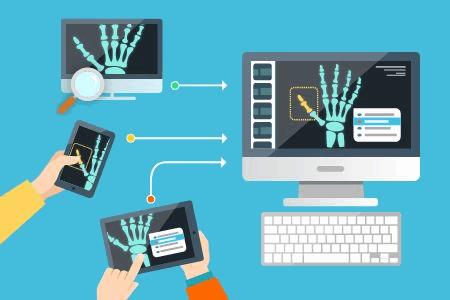DICOM Viewers: A Gate To Online Collaboration

DICOM has been used in healthcare institutions from pole to pole for more than twenty years. Now it resides upon the medical imaging throne since this standard is supported by virtually all medical imaging devices.
Data storage devices like CDs/DVDs and USB flash drives are traditionally used to transport and archive DICOM files. These devices have autorun packages enabling to open the files on any computer, but such an approach does not always work: a device with DICOM files can be lost or damaged. The files can also be stored on a local hard disc or file server to give other healthcare professionals access to them.
If a diagnostician needs to consult other experts before making a diagnosis, he/she has to give them a call asking to open a particular file in an app and the whole discussion is conducted via phone. A person making a call cannot be entirely sure the correct file is opened and the right diagnosis will be made.
There is no doubt about the quality of DICOM files, but accuracy of such a phone diagnosis is doubtful.
Standard DICOM Viewers have limited functionality and diagnostic centers have to ask healthcare software developers and integrators to create custom software for their organization. Major requirements of such customers comprise:
- Automatic processing on photos — auto adjustment of images by improving their brightness and contrast by using latest algorithms for dealing with pixel images.
- Remote collaboration. Let’s discuss this issue in detail:
- The Viewers must give their users an ability to invite other medical experts to join the discussion, open the same images simultaneously and even conduct online researches. Conferencing solutions, meeting scheduler tools (sending of invitations, notifications, etc.) and other solutions can be used to make it possible.

- Tools enabling collaborative working with DICOM images. Taking into account the fact that latest Viewers enable their users not only to view images, but also to zoom separate areas, create animation and even 3D models, development of such tools is a big challenge for their developers. However, developing a solution that would enable such collaborations is the biggest challenge: giving several medical experts an opportunity to collaborate online via a DICOM Viewer is a task that can be executed only by professional software engineers. Users of enhanced solutions can scroll, zoom, turn the same model simultaneously and see changes each of them makes in it.
- A feature enabling users to mark areas of images and 3D models, leave text, voice and video annotations and comments is very important for the Viewers, too, since this information can be used later on in diagnostics and control of the disease.
- Automatic recognition is one of the most lucrative directions of the DICOM images’ analysis. Intelligent software makes it possible to detect separate areas and define their structure, components and functions, thus facilitating the work of a diagnostician and assists in escaping critical errors. It can be used also for semi-automatic control of old images in order to analyze them using the latest diagnostic approaches.
DICOM has proved its efficiency over the years and it is made use of when it comes to exchange medical images and related information. Being used in diagnosis of disease, it helps to save lives. However, development prospects of this direction fall beyond improvement of hardware. Development of intelligent software for data processing, collaborative working, and automation of the diagnostic workflow.
About The Author
Tatsiana Levdikova is a websites design and development expert at EffectiveSoft, a custom software development company. This company unites more than 250 experts: software developers, engineers, scientists, and more. You can reach the Author at contact@effectivesoft.com.
